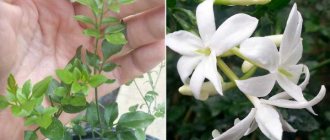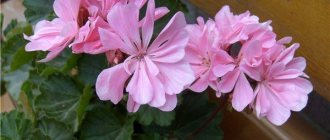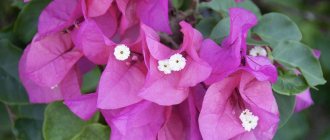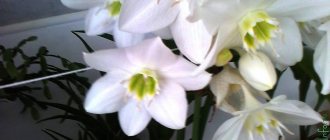Recently, many lovers of house plants can find an unusual and beautiful shrub, which is called indoor hop or crayfish neck due to the fact that the unusual inflorescences of the plant resemble a shrimp or long hop cones. The botanical name of this plant is beloperone. The entire genus of these plants, growing in different conditions, has about 60 varieties and subspecies. Flower growers most often encounter a striking specimen - Beloperone guttata, which will be discussed in this article. Simple home care for beloperone has made this beautiful plant popular, which blooms almost all year round.
An evergreen plant belonging to the Acanthaceae family, it grows as a shrub up to one meter in height. With pubescent stems and unusual inflorescences: orange-red, yellow-pink or brown, downward-sloping bracts that cover long white flower petals. Due to its long flowering period, crayfish can be an excellent decoration for a home or office throughout the year. The place of origin is Mexico, so the shrub loves clean air and sun, but not scorching direct rays. To properly care for indoor beloperone plants, you should know some nuances.
Lighting
The tropical beauty is sun-loving; in low light, its bracts may lose their brightness and become pale. It grows well and feels comfortable in bright but diffused light on the south or southeast side. Beloperone tolerates direct sunlight well only in the morning and evening. In summer, especially during the zenith of the sun, the plant should be provided with light shading.
Due to poor natural light in the winter season, the plant will become very elongated, so it is better to keep it indoors, where artificial lighting is most often used.
Botanical description
Beloperone (lat. Beloperone) belongs to the Acanthaceae family and has about 60 species of plants growing in the tropics and subtropics of America. Some scientists believe that Beloperone is related to the genus Justicia (Justice). The name Beloperone is a combination of two Greek words: “belos” - arrow and “perone” - point, apparently due to the arrow-shaped shape of the anther. The beloperone plant is shrubs and subshrubs with under-lignified shoots, either bare or slightly pubescent, the same bare or slightly pubescent leaves, ovate or lanceolate; axillary yellow, orange, red, and sometimes pink or white flowers, sometimes single, sometimes numerous, collected in semi-umbrellas. Grow in cool, well-lit areas. With proper care, you can achieve rapid growth and almost constant flowering.
The soil
The indoor flower beloperone has genetic characteristics of growth in a certain environment, so you should pay attention to the soil in which it will feel ideal. The mixture is easy to prepare: add one part of humus, as well as peat and sand to 2 parts of turf and leaf substrate. To improve the quality of the soil, experts advise adding a little bone meal to the composition. Experience shows that if it is not possible to prepare such a mixture, then it can be planted in universal soil for growing seedlings.
Mr. Summer Resident explains: crown formation and pruning
The beloperone flower grows very quickly and due to this it can take on different forms: a hanging, standard plant or a dense shrub.
To create a bush, you need to trim the branches to stimulate the buds to develop. When the process is started, the number of flowering branches is increased by pinching.
The process of creating an ampelous one proceeds from the reverse. The branches are not pruned and pinching is not carried out. The flower is not given the opportunity to branch, so that it grows in a single column and begins to bend under its own weight.
For a standard tree, the trunk is propped up and the lower leaves are removed as it grows. The maximum size of the trunk will reach 25-30 cm, the formed crown cap will be 10-20 cm.
Transplantation, pruning, flowering
Every year in spring, Beloperone needs to be transplanted into a larger pot so that the roots have room to grow. Several young petioles can be placed in one pot to give greater bushiness. Later, as they grow older, the bushes can be replanted once every 2 years.
You should regularly trim an adult bush every spring by half or 1/3 of the stems. This increases the branching and volume of the bush. The cuttings remaining after pruning can be used for rooting and new young bushes can be obtained.
With good care at home, Beloperone will bloom constantly. In winter, a short dormant period is possible if the plant needs rest. The flower is unpretentious, a novice gardener can handle it quite well. Such a bright bush will look impressive in the living room, in store windows, in a hotel lobby or in an office.
Breeders have something to do
Over 30 varieties of Beloperone have been found in nature. These are subshrubs and shrubs that never shed their leaves. They grow in the South American tropics and subtropics. As an indoor flower, they mainly grow beloperone drip. This is the most suitable variety for home use. Beloperone breeders have not yet been particularly interested in it. They paid attention only to the color of the inflorescences, creating several interesting hybrids. The bracts are yellow, orange, red and burgundy. Less common are snow-white and pink. Flower growers also grow variegated varieties of Beloperone, with variegated leaves. The most popular:
- Beloperone drip (guttata). A bush growing up to 1 m in height. Its leaves are pointed, egg-shaped. The stems and foliage are covered with light fluff. At the end of the stems there are long, 10 cm or more, inflorescences, similar to a drooping multi-colored ear; inside the flower itself is variegated white and tubular.
- Beloperone Yellow Queen (Yellow Queen). Popular breeding hybrid. The name corresponds to the color of the bracts; they are deep yellow.
- Beloperone Lutea. The inflorescence is collected from pale lemon petals, the flower is white with a purple throat.
- Beloperone Rouge. One of the latest new selections with yellow bracts. The flower itself is red-crimson along the edge, with cream speckled in the middle.
- Beloperone plumfolia (plumbaginifoiia). It is very rare at home. This weakly branched subshrub is native to Brazil. Its straight branches stretch up to one and a half meters. The leaves are narrower than those of drip whiteperone, denser and smoother. The flowers are bright crimson and lack lush bracts. And the entire inflorescence of the lead-leaved white peronea does not look as elegant as that of guttata.
- Beloperone drip variegated. A selection hybrid, the leaves of which contain cells incapable of chlorophyll synthesis. Variegated beloperones are distinguished not only by the varied colors of their bracts, but also by their variegated leaves. Such beauty can only be propagated by cuttings; variegation is not preserved in the genes.
Photo gallery: species grown at home
Beloperone drip is most often found in the apartments of gardeners
Beloperone variegata is a breeding hybrid that differs from the “parent” in the variegated color of its leaves.
Beloperone Yellow Queen has very bright, sunny yellow bracts
Beloperone Rouge is one of the latest achievements of breeders
Beloperone Lutea is bred on the basis of beloperone drip
Beloperone rosea has thin, drooping shoots
Beloperone leadifolia is distinguished by bright, pink-purple bracts
Reproduction
The easiest way to propagate indoor hops is by cuttings. Young cuttings are easy to root. They are harvested from February to May, cutting off in front of a bud about 10 cm long. The branches are left in mixed soil of sand and peat or simply in wet sand. Usually good roots grow in two weeks. To speed up this process, you can use bottom heating, and also treat the cuttings with root, heteroauxin or succinic acid.
Another option for propagating beloperone drip is sowing seeds. They are sown in March - April on the surface of the soil, which is prepared from sand and leaf soil. Seeds germinate in about two weeks at an air temperature of 20 to 25 °C. The grown shoots need to be planted into the soil mixture after the first few leaves appear. It consists of the following proportion: one part each of humus, peat, leaf soil and half part sand. For better branching, the tops of small shoots must be pinched.
Types of beloperone with photos
Beloperone drip (Beloperone guttata)
This species is native to Mexico. The height of the evergreen, highly branched plant is about 100 cm. The oppositely located pubescent leaf plates have an oval or ovoid shape, narrowed towards the petiole. Their length is about 70 mm. During flowering, apical spike-shaped drooping inflorescences are formed, characterized by high density and consisting of white flowers. They reach approximately 20 centimeters in length. The inflorescences grow in the axils of pubescent large bracts of pale red, yellow or greenish-yellow color.
The species has a variety - Beloperone guttata var. longispica purpurea. This is a strongly branching subshrub, the height of which is about 0.8 m. Its shoots are thin and drooping. Green oval-pointed leaf blades have slight pubescence. The color of the inflorescences is white, and the bracts are pale red. It is a highly decorative plant, as its flowering is observed throughout the year.
Diseases and pests
The plant rarely gets sick, but may suffer from poor maintenance. If the bush begins to hurt or experiences discomfort from poor conditions, it will let you know about it. The reaction of the houseplant beloperone will be as follows:
- discoloration of leaves, appearance of spots - due to insufficient nutrition with minerals or increased watering;
- leaves falling if it is too dry and hot;
- leaves turn yellow if it is damp and dark, especially in winter;
- bracts lose brightness in low light;
- flowers and leaves fall off due to very dry soil;
- leaves turn rusty due to direct sunlight and, as a result, burns;
- the stems take on an unusual shape, and the leaves become sticky when attacked by pests that can infest the bush.
Spider mites and aphids are the main enemies of beloperone, but they rarely infect the plant.
| Growing | Bright diffuse lighting, protection from drafts and direct sunlight, temperature 18-20 degrees in summer, 12-16 in winter. |
| Humidity | Moderate. Spraying once a day in summer and once a week in winter, a container with water or wet expanded clay. |
| Feeding and pruning | Fertilize weekly from spring to October, in winter - as needed - 1-2 times monthly. Pruning branches by half in spring. |
| Flowering period | Blooms almost all year round. |
| Landing, transplant | When planting, drainage from expanded clay and sand is needed. Soil - prepare a mixture of the following: add one part each of humus, peat and sand to 2 parts of turf and leaf substrate. Replant when filling the pot with the root system once a year in the spring. |
| Reproduction | Rooted cuttings and seeds. |
| Pests | Spider mites and aphids. |
| Diseases | Rarely occurs if not properly cared for. |
Caring for Beloperone at home
Illumination
Beloperone growing indoors needs to be provided with a large amount of bright light, which should be diffused. However, a little direct sunlight in the evening or early morning will even be beneficial for him. But at the same time, he needs to provide reliable protection from direct sunlight at midday.
The shrub can be placed near a window facing southeast or south. However, he will be most comfortable near the eastern or western window. If you want to achieve abundant flowering in winter, then you will need lighting with fluorescent lamps.
Temperature
In the spring and summer months, the plant feels most comfortable at moderate temperatures (from 18 to 20 degrees). In the autumn-winter period, make sure that the room is no colder than 12 degrees, but not warmer than 16 degrees. Otherwise, all the foliage of the bush may fly off.
Watering
In spring and summer, white peronea needs abundant watering, which should be infrequent. Between waterings, the surface of the substrate should dry well, but do not allow the earthen clod to dry out. Also make sure that water does not stagnate in the root system. In autumn-winter, watering is carried out immediately after the top layer of the substrate has dried. Because if the soil mixture dries out more, the bush may shed all its flowers and foliage.
Air humidity
This crop prefers high air humidity. In this regard, it is recommended to regularly spray Beloperone, which will also help protect the bush from pests. It is recommended to place the flower in a deep tray filled with wet expanded clay or peat.
Fertilizer
Feed the bush with a complete mineral complex. In spring and summer, fertilizer is applied once every couple of weeks, and in the cold season - twice every 3 months. If the bush is warm in winter (above 18 degrees), then it is fed once every 30 days.
Trimming
Domestic white perone is characterized by very fast growth. That is why it needs regular trimming and pinching. Only in this case will the crown always have a neat appearance, and the flowering will be the most magnificent. Do not forget to promptly trim off the inflorescences that have begun to fade.
In order for the bush to grow denser, in spring it is necessary to shorten all its branches by ½ or 2/3. After this, the bush is fed with a mineral complex, while the cut branches can be rooted as cuttings.
In addition, cut stems can be used to grow a standard or ampelous type by regularly removing excess branches. To form a tall bush, you need to cut out all the side branches located below. The remaining bare trunk should be fixed with a support. After the tree has grown to the optimal height, pinch off the top, leaving side shoots nearby that need systematic pinching, which will help in the formation of the crown.
Beloperone transplant
Transplantation is carried out only after the root system becomes crowded in the flower pot. While the bush is young, this procedure is carried out every year. But since this plant is fast growing, it may need two transplants during the summer. When replanting a bush, make sure that the roots are not injured. You can prepare the substrate with your own hands; to do this, combine peat, humus, turf and leaf soil, as well as sand (1: 1: 2: 2: 1). Add a little bone meal to the finished mixture.
Transplanting perennial BELOPERONE
Pest Control
In most cases, drip beloperone is attacked by the most common pests that attack the bulk of indoor flowers. These are insects and mites that feed on plant sap.
| Pest name | Signs of defeat | Fighting methods |
| Spider mite | The cuttings and shoots are covered with a thin web, the inner side of the leaf is covered with light green or yellowish spots | The leaves are wiped with a cotton pad moistened with alcohol or alcohol tincture. After 20 minutes, the plant is thoroughly sprayed with water, the temperature of which should be 40-45 degrees. After this, the affected plant is watered abundantly and placed in a plastic bag for two days. If this method does not bring the desired effect, you can resort to the help of acaricides (Omite, Agravertin, Neoron, Vermitec). Treatment must be carried out 3 or 4 times with an interval of 7 days, changing medications |
| Aphid | Dark brown or yellowish-green insects on the inside of young leaves, flowers and the tops of shoots | Pests are washed off with water or soap suds, and severely damaged parts of the plant are immediately removed. After this, it is necessary to spray the plant with an infusion of a strong-smelling herb - for example, tobacco chips, onions or garlic. Spraying is carried out 3 times a day. You can use drugs such as Iskra-Bio, Inta-Vir, Fury. They treat the plant and soil once a week for a month. |
| Whitefly | Small light colored butterflies. Usually located on plants, they fly up instantly if you touch the flower | You can leave a working fumigator next to the plant and hang adhesive tape against insects nearby. Among the drugs that help in the fight against this insect, Admiral, Mospilan, Commander, and Oberon have proven themselves well. Treat the plant 2-3 times with an interval of 7-10 days |
| Mealybug | White fluff, reminiscent of poplar, in the axils of the leaves and on the shoots, a light coating on the back of the leaves | The affected areas are treated with a soap-alcohol solution, after which the solution is thoroughly washed off. You can treat the plant with Biotlin, Tanrek, Mospilan, Fitoverm. Treatment should be carried out 3 times every week using different preparations |
| Shchitovka | Brown growths form on the leaves, which gradually increase in size. The area around the growth turns yellow or red, and the soil in the pot with the affected plant turns black. | The growths are treated with vinegar, kerosene or turpentine. After 2-3 hours, the scale insects are removed using a cotton pad. Then you should wash the plant with warm water. After this, you should treat the flower with Metaphos, Fosbecid, Fitoverm, Actellik, and repeat the procedure 2-3 times with an interval of 10 days. As a preventative measure, you can spray with tincture of hot pepper. |
Beloperone diseases
Beloperone is resistant to negative factors, but there is a risk of damage by pests. More often the crop is attacked by the following pests:
- Aphid. Leaves curl, change color, and new shoots become twisted. In order to prevent the appearance of aphids, you should take care of the flower and periodically wipe it with a solution of pyrethrum or soapy water; in advanced cases, the culture will be saved by “Fosbecid” or “Aktellik”.
- Whitefly. Occurs on shoots and leaves in warm and humid conditions. Insects especially like poorly ventilated places where plants are planted too often. The insect is afraid of drugs: “Decisom”, “Aktellika”.
- Spider mite. The presence of a parasite is indicated by the yellowness of the foliage and the characteristic silvery web. If the crop is not treated with Actellik at the initial stage of the disease, the plant may wither.
- Shield. It appears as gray-brown growths on leaves and shoots, gradually increasing in volume. The nearest areas of tissue turn yellow or red, and the soil in the flowerpot becomes unnaturally black. The situation requires treating the flower with available means: Metaphos, Fosbecid, Fitoverm, Actellik. After 2-3 hours the pests will die.
It is important to know! During the growing season, red spots often form on the flower, and the leaves quickly fade. These signs indicate improper watering. High temperatures and low lighting cause the bracts to fade. A cramped pot and a lack of useful microelements lead to leaf fall.
Beloperone parasites
Beloperone is an unusual flower, not very popular among gardeners. The culture has many advantages: long and abundant flowering, decorative foliage, ease of care. The plant attracts attention to the rich palette of colors and sophisticated flowering.
General information
In total, the genus Beloperone has from 30 to 60 species, which are distributed in the tropical and subtropical regions of America. Some scientists include this genus in the genus Justitia. Therefore, the plant can often be found under this name.
Beloperone comes from the Greek words “belos” and “perone” and literally translates as “arrowhead”. Evergreen perennial subshrubs or shrubs with pubescent or bare stems. The leaves of the plant can also be pubescent or glabrous with a leaf blade of an elongated ovate or lanceolate shape.
The flowers of the “shrimp plant” are axillary, numerous or single, forming semi-umbrella inflorescences. The color of the flowers is most often yellow, red, orange. There are specimens with white and pink flowers.
Beloperone is one of the few representatives of indoor plants that can bloom almost all year round.
What it looks like and photo
Its root system is very thin. The roots may be long, but their structure is very fragile.
The stem is green in color. Mature plants may show brown peeling.
The leaves are opposite and have a slightly elongated oval shape. Their color is bright green and they are slightly drooping.
The flowers are white, but they are covered by bright bracts located in the inflorescence. Their shade can be pink-yellow, burgundy or red-orange.
When and how does it bloom
A distinctive feature of most species of beloperone is that the subshrub blooms annually for a long time (up to 10 months). Flowering is most active in spring and summer, when its growth occurs. During the dormant period in winter, the flowers tend to fall off, but the bush does not look bare thanks to the large number of green leaves.
White perone blooms brightly. Many inflorescences appear on the bush at once. They originate at the base of the leaves and form a single line. Small white flowers are hidden behind large red bracts 14-16 cm long. It is difficult to see the flowers behind them.
How to replant a flower
Beloperone grows quickly, so it needs regular replanting. For mature plants, it is enough to do this once every 2-3 years, but for young plants every year. In some cases, it may be necessary to transplant a young specimen after 6 months. You can determine the need by the roots that have filled the entire volume of the pot and even look out from the holes at the bottom.
The soil should be light, nutritious, neutral or slightly acidic. You can take universal soil from the store, add humus or vermicompost, and perlite for looseness. Or make the mixture yourself by mixing turf and leaf soil in 2 parts each, adding some sand, humus or humus to them. Some gardeners recommend adding a little chalk or bone meal.
You need to replant the flower into a larger pot.
Transplant stages:
- Remove the plant from the old container. This must be done carefully. It is better to water the flower half an hour beforehand, so it will be easier to remove. If it sits too tightly, tap the sides of the pot a little.
- Drainage should be added to the bottom of the new pot. Expanded clay and small pebbles are suitable. Next, it is filled by a third with earth.
- You should inspect the roots, remove the rotten ones, shorten the bottom by 1-1.5 cm, cutting off the thin ones. Remove some of the old soil.
- Place the plant in a new pot, gradually add substrate and shake lightly so that the soil lies evenly. Then tamp down without pressing too hard so as not to damage the roots.
- Water. Place in a shaded place for 3 days. Then return to the main location and resume the previous watering regime.
After several years of cultivation, the plant can stretch and grow. In this case, it is renewed by cutting cuttings and rooting again.











